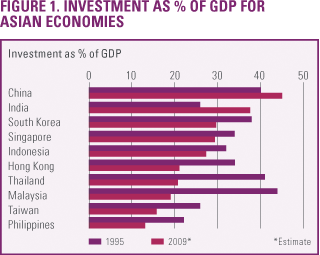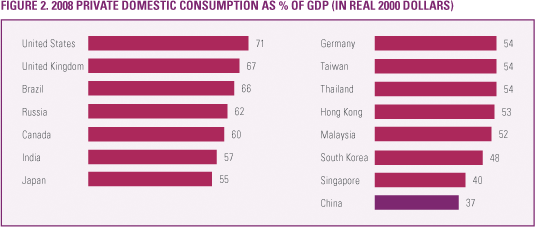Opinion: China’s Consumption Challenge
ETHOS Issue 08, Aug 2010

The growth strategy that has served China so well over the past two decades and lifted millions out of poverty may have reached the point of diminishing returns. China's leaders have been aware that the state-directed model of export and investment-led growth was losing momentum even before the start of the global economic crisis. The developed world's synchronised recession in late 2008 was a system shock to China's export dynamic, and highlighted the vulnerability of China's unbalanced growth model, particularly in a climate of starkly weaker external demand.
Stephen Roach, chairman of Morgan Stanley Asia, has suggested that the post-crisis global economy is likely to experience a multi-year consolidation of the American consumer; export-driven economies like China are expected to face stiff headwinds in the years ahead.1 While the global economy is on the path to recovery, China can no longer depend on the conventional cycle of a robust rebound in global growth that has sustained its export-led growth model since the 1990s. The current European debt crisis and the plunging euro are hurting China's export to its biggest overseas market. Roach warned that if China stays the path of the old growth model and fails to embrace the pro-consumption model, it risks compounding its already formidable imbalances. This is the most apparent in the investment share of China's GDP, which is moving above 45%. This is a record for any major economy and is simply unsustainable for any economy, including China.

Source: Morgan Stanley
CHINA NEEDS A CONSUMER-CENTRIC DOMESTIC ECONOMY
Economists like MIT's Professor Huang Yasheng and Cornell University's Professor Eswar Prasad have suggested that China turn to its greatest asset — its 1.33 billion citizens — whose private consumption capacity has yet to be fully tapped. The need for a pro-consumption transition in the Chinese economy is evident. But can the country's growing army of middle-class consumers be called upon to fill the demand vacuum created by flagging American and European consumer spending?
Stoking China's domestic private consumption is currently a top national policy agenda. As early as the first half of 2007, Premier Wen Jiabao had signalled that while China's economy appeared robust on the surface, it was increasingly "unstable, unbalanced, uncoordinated and ultimately unsustainable".2 In September 2009, Premier Wen emphasised that China should "make greater effort to enhance the role of domestic demand, especially final consumption, in spurring growth" and highlighted that this would be "a long-term strategic policy for China's economic growth".3 It is evident that even a competitive export-driven economy like China could not sustain rapid increases in living standards without an accompanying degree of broad-based private consumption — which should arise as a consequence of economic growth, and which can then fuel the next cycle of demand and supply.
While the global economy is on the path to recovery, China can no longer depend on the conventional cycle of a robust rebound in global growth that has sustained its export-led growth model since the 1990s.
Indeed, the International Monetary Fund has noted that "raising private consumption over the longer term through structural reforms that lower precautionary savings would provide a large impetus to output growth and reduce the need for gaining further [international] market share. It could allow productive capacity in tradable sectors to be directed to the internal market and new capacity built in sectors that serve local consumers. As such, it would avoid the limits to over-reliance on export-oriented growth that were seen in other major exporters such as Japan and Korea".4
The Reluctant Chinese Consumer
At present, China has by far the lowest share of private consumption to GDP in Asia. Even though consumer spending is increasing, it is not growing rapidly enough. Private consumption has actually been declining as a share of GDP, from 46% in 2000 to a mere 35% in 2008.5 In 2008, China's consumption-to-GDP ratio was only half that of the United States and about two-thirds those of Europe and Japan. On the other hand, household saving rates in China have been escalating. From 1995 to 2008, the average urban household saving rate in the country increased by 11% to about 28% of disposable income.6
This reluctance to spend and consume may have cultural roots. Observers such as Minister Mentor Lee Kuan Yew have pointed out that the Chinese citizenry's pro-savings mindset is "deep-seated, born of centuries of deprivation. Their experience over the millennia is that during floods, famine, pestilence, earthquakes and war, the central government will not rescue them; therefore, savings are vital to survival."7
The challenge of low personal income growth has been further compounded by the lack of income security as a result of inadequate social safety provisions.
Lack of Private Income Growth and Security
Low private consumption in China can also be attributed to low personal income growth. China has experienced rapid economic growth over the past two decades as a result of tremendous external demand for its goods. In the post-economic crisis period, China's strategy of paying low wages to its workers and depending on external consumers to absorb surplus production is likely to be far less effective. China may now need to emphasise personal income growth over production. However, the 2009 stimulus package demonstrated that the Chinese economy was not moving in this direction. On the contrary, China increased government spending and investment by state-owned enterprises to cushion the impact of weak exports, instead of implementing necessary measures to boost the income of its citizens.

Source: McKinsey Global Institute
The challenge of low personal income growth has been further compounded by the lack of income security as a result of inadequate social safety provisions. Analysts have highlighted several critical developments that may account for excessive savings among Chinese households. First, massive downsizing due to state-owned enterprise reforms over the past one-and-a-half decades has led to job and income insecurity. Some estimates put the total job loss associated with such restructuring efforts at over 65 million workers since the mid-1990s.1
Second, the lack of a social safety net to protect displaced workers has rendered it difficult for them to draw down excessive levels of precautionary savings. Many of these workers used to derive immense security from lifetime employment, a steady income and the benefits of an "iron rice bowl" integral to state-owned enterprises in the past. The loss of these provisions means that households may now be saving more to cushion themselves from the effects of growing macroeconomic uncertainty as China transits to a market-oriented economy.
Third, the escalating private burden of expenditures on housing, education and health care may be encouraging precautionary saving. This may also have been amplified by an "underdeveloped financial system, which provides low returns on bank deposits and constrains borrowing against future income."7
Structural Features Inhibit Private Consumption
Current economic arrangements in China also greatly favour large, mostly state-owned industrial companies, which enjoy preferential financing from state-controlled banks, and exercise significant monopoly power (especially in sectors like telecommunications and energy). This stems from the beliefs among the Chinese political elites that deregulation could be a main source of market volatility and the state sector should play an instrumental role in promoting stable economic growth. This state of affairs limits employment growth and disadvantages consumers, discouraging households from spending their relatively modest and shrinking share of the national income. Presently, Chinese households command only some 56% of national income, compared with more than 60% in Europe and more than 70% in the United States.8
Policy Measures to Boost Private Consumption
Any policy intended to boost domestic private consumption needs to address structural factors that both channel income away from consumers and discourage them from spending their share of national income. There is evidence that the Chinese government recognises the challenge of inadequate social safety net and the need for structural reforms.
In August 2000, the Chinese government set up the National Social Security Fund, a strategic reserve fund to mitigate the looming ageing crisis and help provide financial protection for pensioners. By the end of 2009, the fund had RMB776.6 billion of assets under management.9 The State Council also enacted a 3-year RMB850 billion national health insurance plan in January 2009 to provide basic medical security to all Chinese in urban and rural areas, improve the quality of medical services and make medical services more accessible and affordable to ordinary people. While the plan aims to provide some form of insurance for 90% of the population by 2011, each person covered by the system would only receive an annual subsidy of RMB120, starting in 2010.10
Measures to make goods and services better and more easily available could encourage consumption much more than strengthening the social safety net.
Since mid-2009, the Chinese government has expanded subsidies to help the country's vast rural population purchase home appliances and automobiles as part of its efforts to boost domestic consumption. They have also loosened consumer credit in the short term to encourage spending. In the longer term, however, the financial uncertainties faced by Chinese citizens can only be countered by major policy initiatives in social security, pension system, health care and unemployment insurance. Although China's 11th Five-Year Plan in early 2006 had established a broad framework for advancement to a consumer-driven growth model, there may need to be an expansion of social security policies in the 12th Five-Year Plan, which runs from 2011 to 2015. According to the China Development Research Foundation, a government think-tank, the state would need to invest RMB5.74 trillion by 2020 to establish a comprehensive social welfare system for its citizens.11 This would encompass pensions, education, health care, housing, employment as well as aid to rural residents and migrant workers.
Nonetheless, better health and pension benefits cannot guarantee a significant boost in private consumption. It depends on how the social security framework is financed. If enhanced social security benefits are financed through increased income taxes, households would have less money to spend, notwithstanding reduced pressure to save for rainy days. Much would depend on the impact of income allocation on private consumption. There may need to be policies to channel more income to the households (vis-à-vis the state and enterprises) which would require a macroeconomic adjustment via new fiscal policies. Another approach might be to enhance other revenue sources such as capital gains, inheritance and property taxes. State-owned enterprises could pay dividends to the government to finance social security. By increasing the income share of households, citizens would enjoy greater means to consume.
Deficiencies on the supply side of domestic consumption would also need to be tackled. Measures to make goods and services better and more easily available could encourage consumption much more than strengthening the social safety net. Given the largely underdeveloped consumer infrastructure in rural China, the development of large-scale consumer goods and services industries, especially retail, hospitality, transportation, logistics and other commercial services could be a real boon to China's employment and social stability imperatives. This can only be achieved if the state invests more in the service sector and if public policy is more favourable to small and medium enterprises as well as to private-sector development.
CONCLUSION
The Chinese government is sensitive to any signs of social instability. In the face of a global economic crisis, it announced in November 2008, a RMB4-trillion (US$586 billion) fiscal stimulus which was designed primarily to arrest politically-unacceptable unemployment rates. This was implemented despite the risks of intensifying both overcapacity and overdependence on investment and exports. The two trends of increasing Chinese investment and waning American as well as European consumption are simply incompatible and China's export-oriented growth will be unsustainable under such a scenario. Hence China must find ways to expand its domestic demand on a lasting and substantial basis. But there is no single magic bullet for making a quick shift from excessive dependence on exports and investment. Policy innovations will be needed to promote private consumption and to ensure more balanced growth of the Chinese economy.
A consumer-led rebalance will result in a more sustainable growth model for China. This development will help to mitigate the country's overwhelming labour absorption problem and buffer the Chinese economy from future global demand shocks. This will also allow China's trading partners to participate in the expansion of its enormous base of domestic demand, thereby reducing their trade deficits with China. In addition, a major shift away from the industrial production underpinnings of exports and investment will also make growth less energy and resources intensive, as well as more environmentally sustainable. As the transition will bring about increased domestic investment, it could boost the productive capacity of the Chinese workers and help reduce income inequality. If China succeeds in making a major strategic shift in its growth model and adopts pro-consumption structural changes, it could reap significant benefits towards its aspirations of a harmonious society, with higher standards of living for Chinese citizens as well as greater regional and global economic stability in the long term.
NOTES
- Roach, Stephen, "Wake-up Call for the Next Asia", Morgan Stanley, 19 October 2009, http://stock-report.blogspot.com/2009/10/wake-up-call-for-next-asia-morgan.html
- Chan, John, "World Economic Forum: False Hopes in a China-led Recovery", World Socialist Web Site, 18 September 2009, http://www.wsws.org/articles/2009/sep2009/chin-s18.shtml
- "Wen: Domestic Demand Stressed to Drive Growth", China Daily (10 September 2009), http://www.chinadaily.com.cn/china/2009-09/10/content_8678713.htm
- Guo, Kai and N'Diaye, Papa, "Is China's Export-Oriented Growth Sustainable?" IMF Working Paper WP/09/172, International Monetary Fund (August 2009), http://www.imf.org/external/pubs/ft/wp/2009/wp09172.pdf
- Schuman, M., "Can China's Backwaters Save the Global Economy?", Time Magazine (30 November 2009).
- Prasad, Eswar, "Spend China Spend! Rebalancing Growth in Asia Depends on Chinese Consumer Spending", Forbes Magazine (2 August 2009), http://www.brookings.edu/opinions/2009/0802_china_spending_prasad.aspx
- Lee, Kuan Yew, "Changes in the Wind", Forbes Magazine (19 October 2009), http://www.forbes.com/forbes/2009/1019/opinions-lee-kuan-yew-east-asia-current-events.html
- "A Consumer Paradigm for China", McKinsey Quarterly (August 2009), https://www.mckinseyquarterly.com/ghost.aspx?ID=/A_consumer_paradigm_for_China_2429/
- 09. National Council for Social Security Fund 2009 Annual Report. http://www.ssf.gov.cn/ndbg/201005/t20100510_ 2709.html
- "China Plans Universal Health Care", The New York Times (22 January 2009), http://www.nytimes.com/2009/01/22/world/asia/22iht-beijing.1.19590543.html
- "China to boost spending on welfare, education, health care", China Daily (5 March 2009), http://www.chinadaily.com.cn/china/2009-03/05/content_7542377.htm

